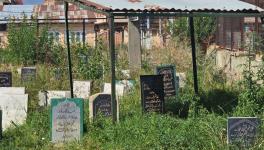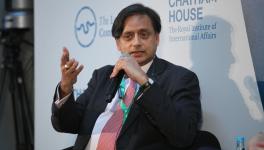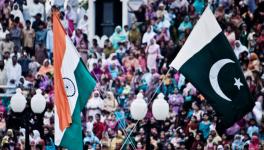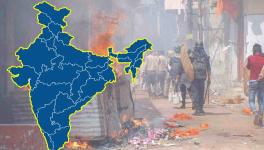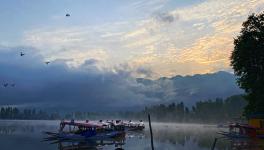In Kashmir’s Silence, Read a Warning
One man’s beard is on fire, and another man warms his hands on it. So goes the Kashmiri proverb. No Kashmiri could have envisioned that a day would come when the proverb would haunt them with such ferocity. As they seethe under restless uncertainty in the aftermath of the gutting of their ‘special status’ and wait in anticipation for worse things to befall them, much of the rest of India celebrates as if a territory has been conquered.
It is two weeks and counting that the local media is totally silenced. Even the otherwise informed, therefore, have no way of knowing what is happening in the Valley. Anuradha Bhasin, the editor of Kashmir Times, laments that in one critical sense at least the situation is even worse than what prevailed in the 1990s. Although journalists were targeted then too, they were targeted by both militants and the state machinery. Today, the democratic state has monopolised such repression.
The mood in Delhi’s power circles is exactly the opposite. Six years ahead of its centenary, the Hindu nationalistic Rashtriya Swayamsevak Sangh (RSS), which views India as a nation of Hindus, for Hindus and by Hindus, has been presented with a much-coveted gift: Muslim-majority Kashmir. They are thankful to their political arm, the Bharatiya Janata Party (BJP), for making it possible; an effort that started as early as 1951, when the BJP’s forerunner, the Bharatiya Jana Sangh, was established.
The state of Jammu and Kashmir (J&K) has all along been a test case for both India’s secularists and its Hindu nationalists. If J&K remained multi-religious, with a majority Muslim population, it would have been a statement of success for India’s secularists; but if it failed to remain as such, it was a victory for the Hindu nationalists. Buddhist-majority Ladakh was peripheral in this essentially Secular-Hindu contestation.
This critical element, the contest between secularism and a Hindu Rashtra, is virtually missing in the present discourse over the future of Kashmir triggered by the fateful decision of August 5, 2019. On that day, J&K as a state of the Indian Union disappeared and in its place emerged two Union Territories -- Jammu and Kashmir, and Ladakh.
Logically, given the BJP’s known sympathy for the Hindu-majority Jammu region, J&K should have been divided into three, not two UTs. It is possible that the RSS/BJP is testing the waters. Once the surface turmoil subsides, it may conduct a second surgery and further divide the UT of J&K.
Leaving aside such speculation for the moment, let us instead consider the following: First, what has happened on the ground. Second, what is the state’s history and third, how can one address the handling of Kashmir Valley, which has a history of protest and disaffection. To put it in poetic terms, what lies in store for the ‘idea of India’ or its ‘unity in diversity’.
Two constitutional provisions that governed the Indian state’s relationship with the erstwhile J&K state now stand de-operationalised. These are Article 370 and Article 35A. The first established the state’s ‘special status’ vis-à-vis the Indian Union, though regular tampering with its provisions had reduced it to a hollow shell, retaining form but little of its original substance.
Article 35A was an addition to the Constitution effected in 1954 through a presidential order that was never endorsed by Parliament. As such, its legality was contentious and the matter was pending with the Supreme Court for adjudication. Given the actions of August 5, any concern over its legality has clearly been overtaken by events. Or, might we still expect the Supreme Court to hear the case?
Of the two, Article 35A is the bigger bone of contention and Hindutva forces were particularly keen to get rid of it. The reason was that it gave the J&K legislature virtually a blank cheque to decide who qualified as a ‘permanent resident’ of the state and was thus eligible for special privileges and rights when it came to public sector jobs, property ownership, state scholarships and other aid packages.
There is no dearth of such special privileges in many other states but what mattered in the case of J&K was that it was a Muslim-majority state and that the means of implementing the article were not constitutional. Ideally, its unconstitutionality alone should have been addressed, and not its contents. Politically, it is always important to assuage the fear of a minority community in a border region by allowing it to preserve its identity. It has been abundantly done in India’s North-East (Nagaland, for example). But, obviously, the Muslim factor weighed heavily in finding fault with Article 35A.
In the end, these are relatively simple questions that warrant relatively simple legal answers. Tackling them does little to help us deal with a larger, more complicated, question: what exactly is the BJP trying to achieve through its Kashmir gamble? And that brings us to an even bigger question: how will the BJP’s Kashmir gambit affect India’s broader commitment to secularism and federalism? In short, what will happen to its so-called ‘unity in diversity’? Some, such as the French India expert Christophe Jaffrelot, have already begun to posit that India is now set for a ‘unity in unity’ model.
Ever since the days of the Jana Sangh, Pandit Jawaharlal Nehru has been the bête noire of Hindutva forces precisely because he stood for secularism and federalism. Nehru has been dead now for more than 55 years, yet his ghost still haunts the Hindutva right. Not a day passes that he is not ridiculed by them, either directly or through their social media outlets, as if he is the architect of all that ails India today. In the context of Kashmir, the accusations against him are boundless.
Many insist that Nehru was naïve to have incorporated the special status clauses for J&K in India’s constitution. My understanding of the situation prevailing in 1947-48 leads me to reject such a proposition. It is easy to read history backwards and blame Nehru for not accepting the entire state of J&K as a full state of the Indian Union when the Maharaja of Kashmir had technically acceded to India.
But remember that the Maharaja had acceded to India under duress. Pakistan had attacked Kashmir. A popular movement led by Sheikh Abdullah was making the continuation of the kingdom as an independent entity (as the Maharaja desired) untenable. Hindu-Muslim riots had broken out in Jammu, triggered by Muslims and then there was a massive retaliation by the Maharaja’s men, who killed a large number of Muslims.
In short, the situation was murky. The only redeeming feature was that Nehru and Abdullah were political buddies, which was a matter of enormous significance in the contemporary context. Article 370 was the sum total of this understanding, a comprise formula: the best of a bad deal.
But as soon as Abdullah tried to be difficult by selectively using his communal as well as international cards, Nehru became as ruthless a statist as classical theories of statecraft would prescribe. He had no compunction in jailing Abdullah in 1953.
In politics, as in real life, symbolism matters. And therein lay the relevance of Article 370, which served the critical purpose of containing Kashmiri disaffection against the Indian state without appearing to be aggressive. Those aware of its prognosis over the past 70 years know that it was mauled beyond recognition by successive governments. But Kashmiris could tolerate this watering down as long as its symbolism was retained. By now de-politicising the Article, the BJP has deprived itself of this symbolism. As the situation unfolds, both in the Valley and in Delhi, a heavy price may have to be paid.
The challenge now for the Modi government is how to proceed from here, particularly because it has burnt all political bridges. Among the first things the BJP did was to lock up any Kashmiri leader worth his or her salt. This included pro-India secular leaders such as Farooq and Omar Abdullah and Mehbooba Mufti. How can politics be conducted in a political vacuum?
Prime Minister Narendra Modi has vowed to exorcise the ghosts of the ‘political dynasties’ of the Abdullahs and the Muftis from the state. Should not somebody remind him that until recently his own party broke bread with Mehbooba Mufti, in the form of a ruling alliance in the state with Mufti’s People’s Democratic Party (PDP).
The BJP appears to operate on the theory that as long as a dynastic politician is an ally (a junior ally at that), all is fine, for, ipso-facto she or he become a subscriber to the party’s Hindutva ideology. The moment they oppose the BJP, they become a contagion that must be quarantined.
Given that the BJP can draw upon virtually inexhaustible party funds to buy allegiance, it is more than likely that it will soon recruit second or third rung Kashmiri Muslim politicians to do its bidding in the Valley. The prevailing anti-India anger in the Valley may delay this outcome for some time yet but cannot, in all probability, prevent it.
Much may happen in the meantime. We know that the modern State has a tremendous capacity to suppress information and browbeat street unrest, but we also know that the modern state is equally vulnerable in the face of sustained popular unrest and allegations of human rights violations. One waits with bated breath for when politics returns to the street.
It is undeniable that the BJP has unleashed a frenzied religious politics that is bound to snowball. The ongoing agitations by the Dalits in Delhi and other parts of north India over the demolition of a temple of their deified icon, Ravidas, in Delhi is just one indication (among many) that religion has emerged as the sole mobilising factor in Indian politics. Even the secular Aam Aadmi Party (AAP) now governing Delhi is changing its idiom fast, to dent the BJP’s Hindu base.
In the long run, this may be to the good, for unbridled religious politics will ultimately collapse under its own weight. But before that happens, it will inflict much damage to India’s composite culture. The fear is that it would give rise to religion-fed terrorism, which the Muslim world knows much more intimately than the non-Muslim rest.
In the absence of open-ended democratic politics, a sequestered Kashmir, which has so far seen Pakistan-sponsored and, to a lesser extent, home-grown terrorism, could become a veritable breeding ground for a much wider militancy. As the saying goes, an answer to bad politics is not no politics but more politics. Let us not get carried away by the current “silence of the lambs” to console ourselves that all is well.
Recall the work of Paul Wilkinson, a doyen of terrorism research. Wilkinson has theorised that the ultimate goal of a terrorist group is to provoke the state to such an extent that it eventually indulges in competitive terrorism targeting the common man. Once that stage is reached, the terrorist group has a much larger catchment to draw its future recruits from.
All those who are fascinated with the idea of a strong, no-nonsense state and dismissive of human rights activism are requested to reflect on this formulation.
I do not want to be a doomsday forecaster, but I also cannot forget what former Mumbai police chief Julio Ribeiro said in 2002. In the Shah Alam camp of Ahmedabad, where many Muslim victims of the Gujarat riots were sheltered, he observed a frightening silence among its youngest inmates.
Ribeiro wrote prophetically in the Times of India of April 24, 2002:”‘I do not know if the VHP [Vishwa Hindu Parishad] and the Bajrang Dal [a violent Hindutva brigade], who had been gloating over their ‘success’ in Gujarat, visualised the danger to which they are exposing their innocent co-religionists somewhere, sometime in the future.” I hope that his fears are not realised in Kashmir.
Since no discussion on Kashmir is possible without referring to Pakistan, here is just one point: The abolition of Kashmir as a state in the Indian Union has neutralised India’s moral superiority vis-à-vis Pakistan. The latter has always been ambivalent about its raison d’être, particularly after the creation of Bangladesh. But now its leadership will revamp its mass religious appeal: ‘Didn’t we say that Hindus and Muslims cannot live together as our Quaid-e-Azam had always feared?’
It would legitimise the quasi-democratic, but actually militaristic, regime of Pakistan to the further detriment of the country’s fragile democratic constituency, which has been fighting a most difficult battle for decades to change the nature of Pakistan polity.
The problem of playing religious politics, as many parties do, is that it is easy to light the fire, but much more difficult to extinguish it. Once the embers reach the masses, it spreads like wildfire, vitiating the day-to-day life of the common man. Some time ago, a Hindu customer cancelled his Zomato food delivery order because the delivery agent was a Muslim. Even more recently, the online hotel aggregator, OYO Rooms, denied a booking to a person because he was a Kashmiri Muslim. Though the OYO top brass took the particular staff to task for such obnoxious behaviour, the damage was done.
OYO’s prospective client, Jamia Millia Islamia student Malik Aabid, said, ‘I appreciate this message [of apology from OYO] but don’t think me and my friend will be able to get over with the humiliation we encountered on 17 August. It has alienated [enhanced, sic] our sense of [being the] Other.”
Multiply this sense of alienation, of being ‘othered’, by seven million to begin to get a sense of Kashmiri Muslim alienation following the obliteration of their state.
Postscript: During a recent visit to Cambodia my son (who is half-Kashmiri) encountered a local Kashmiri shopkeeper. Out of curiosity, he enquired which part of Kashmir, Indian or Pakistani, he is from. The shopkeeper’s response was evasive, but meaningful, ‘Kya pharak parta hai, hum to dono taraf se kuchle jaa rahen hain’—how does it matter, we are oppressed by both.
Partha S Ghosh is a senior fellow at the Institute of Social Sciences. Views are personal.
Get the latest reports & analysis with people's perspective on Protests, movements & deep analytical videos, discussions of the current affairs in your Telegram app. Subscribe to NewsClick's Telegram channel & get Real-Time updates on stories, as they get published on our website.









